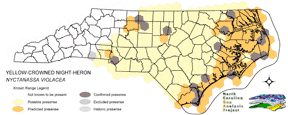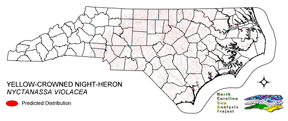
| Taxa: |
| Order: |
| Family: |
| Aves |
| Ciconiiformes |
| Ardeidae |
| NatureServe Global Rank: |
| NatureServe State (NC) Rank: |
| G5 |
| S3B,SZN |
| Federal Status: |
| NC State Status: |
| --- |
| W2,W3 |


| Land Unit |
| US Fish & Wildlife Service |
| US Forest Service |
| US National Park Service |
| US Department of Defense |
| NC State Parks |
| NC University System |
| NC Wildlife Res. Com. |
| NC Forest Service |
| NC Div. of Coastal Mgmt. |
| Local Governments |
| Non-Governmental Org. |
| Other Public Lands |
| Private Lands |
| GAP Status 1-2 |
| All Protected Lands |
| Statewide |
| Hectares |
| 5,265.90 |
| 1,925.19 |
| 7,043.31 |
| 421.83 |
| 2,032.47 |
| 471.24 |
| 5,910.75 |
| 281.61 |
| 287.91 |
| 807.93 |
| 1,689.48 |
| 238.86 |
| 424,454.49 |
| 13,196.25 |
| 24,652.08 |
| 450,830.97 |
| Acres |
| 13,012.32 |
| 4,757.25 |
| 17,404.39 |
| 1,042.36 |
| 5,022.34 |
| 1,164.46 |
| 14,605.78 |
| 695.87 |
| 711.44 |
| 1,996.44 |
| 4,174.80 |
| 590.24 |
| 1,048,849.68 |
| 32,608.64 |
| 60,916.60 |
| 1,114,027.37 |
| % of Dist. on |
| Prot. Lands |
| 21.4 % |
| 7.8 % |
| 22.2 % |
| 1.7 % |
| 8.2 % |
| 1.9 % |
| 23.6 % |
| 1.1 % |
| 1.2 % |
| 6.8 % |
| 6.8 % |
| 0.8 % |
| 0.1 % |
| 53.5 % |
| ----- |
| ----- |
| % of Dist. on |
| All Lands |
| 1.2 % |
| 0.4 % |
| 1.6 % |
| < 0.1 % |
| 0.5 % |
| 0.1 % |
| 1.3 % |
| < 0.1 % |
| < 0.1 % |
| 0.2 % |
| 0.4 % |
| < 0.1 % |
| 94.1 % |
| 2.9 % |
| ----- |
| ----- |
|
Resident of the coastal plain, sandhills, barrier islands, and very rarely into the piedmont (Hamel 1992, Potter et al 1980). The Yellow-crowned night heron occurs in both fresh- and salt-water wetlands (Fussell 1994). It breeds in dense woods or thickets near water, such as in swamps, riverbottom forests, woodlands around freshwater ponds and lake, and coastal thickets (Hamel 1992, Potter et al 1980). Kaufman (1996) describes this wading bird as seldom in open marshes. Yellow-crowned night herons nest in isolated pairs or small groups on the outer periphery of major heronies (Kaufman 1996, Potter et al 1980). Nests are usually built in a small tree or shrub, and can be 1 foot to 50 feet above the ground or over water (Hamel 1992, Harrison 1975, Potter et al 1980). The main component of the nest is sticks, with a lining of twigs, rootlets, and occasionally leaves (Kaufman 1996, Palmer 1962). Nests are preferably in swamps (Hamel 1992), but have been located in trees within cities or suburbs (Kaufman 1996). Forages on the shores of bodies of water, primarily freshwater habitats (Hamel 1992). NATURE SERVE GLOBAL HABITAT COMMENTS: Marshes, swamps, lakes, lagoons, and mangroves; chiefly coastal. Mostly in large cypress swamps in Louisiana, in mangroves in Florida. Prefers mangroves and gallery forest for roosting (Costa Rica, Stiles and Skutch 1989). Nests in trees in wooded situations near water, occasionally in arid scrub on islands; sometimes on ground. Along U.S. Gulf Coast from Alabama to Texas, seems to prefer inland freshwater habitats and riverine swamps for nesting (Spendelow and Patton 1988). Nested 8-23 m up in loblolly pines in Virginia, 20-1100 m from water, primarily in highly populated residential areas (Watts 1989). |
| Code | Name | Description | NC Natural Heritage Program Equivalent |
| 124 | Maritime Scrubs and Tidal Shrublands | Coastal shrubs including wax-myrtle, swamp rose, alder, yaupon, and greenbriar. | Maritime Shrubs, Salt Shrub |
| 75 | Tidal Swamp Forest | Swamp tupelo dominated forest with or without black tupelo and/or cypress trees. Restricted to the tidal zones in the coastal plain. May have inclusions of coastal red cedar woodlands. | Tidal cypress - gum swamp |
| 121 | Maritime Pinelands | Loblolly forests and woodlands of the outer coastal plain. | Estuarine Fringe Loblolly Pine Forest |
| 17 | Maritime Forests and Hammocks | Maritime forests and woodlands dominated by live or sand laurel oak. Estuarine Fringe forests dominated by loblolly pine. | Coastal Fringe Evergreen Forest, Maritime Deciduous Forest, Maritime Deciduous Forest |
| 126 | Interdune Wooded Depression Swamp | Includes swamps dominated by sweetbay and swampbay or dogwood dominated forests. | Maritime Shrub Swamp, Maritime Swamp Forest |
| 380 | Coastal Plain Fresh Water Emergent | Emergent vegetation in fresh water seepage bogs, ponds and riverbeds of the coastal plain. Includes alliances dominated by sedges, eelgrass, as well as cane found in unforested cane-brakes. | Small Depression Pond, Sandhill Seep, Floodplain Pool, Unforested Floodplain Canebrake, Riverscour Prairies, Vernal Pools |
| 173 | Coastal Plain Riverbank Shrubs | Shrub dominated riverbanks, commonly dominated by willows and/or alders. | Sand and Mud Bar |
| 50 | Coastal Plain Mixed Bottomland Forests | Includes forests dominated by a variety of hardwood species, including sweetgum, cottonwood, red maple. | Coastal Plain Bottomland Hardwood (in part), Coastal Plain Levee Forest |
| 49 | Coastal Plain Oak Bottomland Forest | Bottomland forests dominated by deciduous oak alliances. Oaks represented can include swamp chestnut, cherrybark, willow, and/or overcup oak. Inclusions of loblolly pine temporarily flooded forests occur in patches. Hydrology is temporarily to seasonally flooded. | Coastal Plain Bottomland Hardwoods (in part) blackwater subtype, brownwater subtype |
| 30 | Cypress-Gum Floodplain Forests | Swamps dominated by black or swamp tupelo with or without Taxodium. Seasonally to semi-permanently flooded hydrology. | Cypress-Gum Swamps |
| 78 | Pond-Cypress - Gum Swamps, Savannas and Lakeshores | Cypress dominated swamps and lakeshores. Can include bays dominated by pond cypress or shorelines of coastal plain lakes with a narrow band of cypress. | Non-riverine Swamp Forest, Natural Lakeshores (in part) |
| 385 | Oak Bottomland Forest and Swamp Forest | The swamp chestnut oak, cherrybark oak, shumard oak and sweetgum alliance is one representative. Other alliances are dominated by water, willow, and overcup oaks. Swamp forests can be dominated by sweetgum, red maple, and black gum being dominant. Loblolly can occur in combination with sweetgum and red maple, or with tulip poplar. Includes saturated and semi- to permanently flooded forests in the mountains. | Piedmont/Mountain Bottomland Forest, Piedmont/Mountain Swamp Forest |
| 238 | Piedmont/Mountain Submerged Aquatic Vegetation | Seasonally to permanently flooded areas with aquatic vegetation. Waterlily, pondweed, hydrilla smartweed are a few of the species that can occur. | Piedmont/Mountain Semipermanent Impoundment (in part) |
| 239 | Piedmont/Mountain Emergent Vegetation | Emergent vegetation of all wetland hydrologies. Sites would commonly support species such as tussock sedge, rushs, and cattail alliances. | Rocky Bar and Shore (in part) |
| 267 | Riverbank Shrublands | Riverside shrubs with temporarily flooded hydrologies. Found in the both the Mountains and Piedmont. Containing dominants such as smooth alder and a Carolina or black willows. | Sand and Mud Bar |
| 269 | Floodplain Wet Shrublands | Saturated shrublands of the Piedmont, includes buttonbush, swamp-loosestrife, decodon and alders. | Piedmont/mountain Semipermanent Impoundment |
| 230 | Piedmont Mesic Forest | American Beech - Red Oak - White Oak Forests. | Mesic Mixed Hardwood |
| 384 | Piedmont/Mountain Mixed Bottomland Hardwood Forests | Includes temporarily to seasonally forests dominated by hardwood species. Hardwoods include sweetgum, red maple, sycamore which co-occur in a mosaic of bottomland and levee positions. Includes alluvial hardwood forests in the mountains. Hemlock and white pine may occur as inclusions, but are generally mapped separately. | Piedmont/Mountain Alluvial Forest, Piedmont/Mountain Levee Forest |
| 202 | Residential Urban | Includes vegetation interspersed in residential areas. Includes lawns, mixed species woodlots, and horticultural shrubs. Vegetation accounts for between 20 - 70% of the cover. | No equivalent |
| 8 | Open water | Open water without aquatic vegetation. | No equivalent |
|
Riegner, M. F. 1982. The diet of yellow-crowned night-herons in the eastern and southern United States. Colonial Waterbirds 5:173-176.
Fleury, B. E., and T. W. Sherry. 1995. Long-term population trends of colonial wading birds in the southern United States:the impact of crayfish aquaculture on Louisiana populations. Auk 112:613-632. Hamel, P. B. 1992. The land manager's guide to the birds of the south. The Nature Conservancy, Chapel Hill, North Carolina. 367 pp + several appendices. Fussell, J.O. III. 1994. A birderís guide to coastal North Carolina. Chapel Hill and London: The University of North Carolina Press. Kaufman K. 1996. Lives of North American Birds. Boston, New York: Houghton Mifflin Company. American Ornithologists' Union. 1989. Thirty-seventh supplement to the American Ornithologists' Union Checklist of North American birds. Auk 106:532-538. Watts, B. D. 1989. Nest-site characteristics of yellow-crowned night-herons in Virginia. Condor 91:979-983. Harrison, H.H. 1975. A field guide to bird's nests in the U.S. east of the Mississippi River. Houghton Mifflin Company, Boston, Massachusetts. 257 p. Payne, R. B., and C. J. Risley. 1976. Systematics and evolutionary relationships among the herons (Ardeidae). Univ. Michigan Mus. Zool., Misc. Publ. No. 150. 115 pp. Potter, E. F., J. F. Parnell, and R. P. Teulings. 1980. Birds of the Carolinas. Univ. North Carolina Press, Chapel Hill. 408 pp. Terres, J.K. 1980. The Audubon Society encyclopedia of North American birds. Alfred A. Knopf, New York. American Ornithologists' Union (AOU), Committee on Classification and Nomenclature. 1983. Check-list of North American Birds. Sixth Edition. American Ornithologists' Union, Allen Press, Inc., Lawrence, Kansas. National Geographic Society (NGS). 1983. Field guide to the birds of North America. National Geographic Society, Washington, D.C. Hilty, S.L., and W.L. Brown. 1986. A guide to the birds of Colombia. Princeton University Press, Princeton, New Jersey. 836 pp. Root, T. 1988. Atlas of wintering North American birds:An analysis of Christmas Bird Count data. University of Chicago Press. 336 pp. Spendelow, J.A., and S.R. Patton. 1988. National atlas of coastal waterbird colonies in the contiguous United States:1976-1982. U.S. Fish and Wildlife Service, Biological Report 88(5). x + 326 pp. Byrd, M.A., and D.W. Johnston. 1991. Birds. Pages 477-537 in K. Terwilliger, coordinator. Virginia's endangered species:proceedings of a symposium. McDonald and Woodward Publ. Co., Blacksburg, Virginia. Stiles, F.G., and A.F. Skutch. 1989. A guide to the birds of Costa Rica. Comstock Publ. Associates, Cornell University Press, Ithaca, New York. 511 pp. |
For more information please contact them at:
NC-GAP Analysis Project
Dept. of Zoology, NCSU
Campus Box 7617
Raleigh, NC 27695-7617
(919) 513-2853
www.basic.ncsu.edu/ncgap